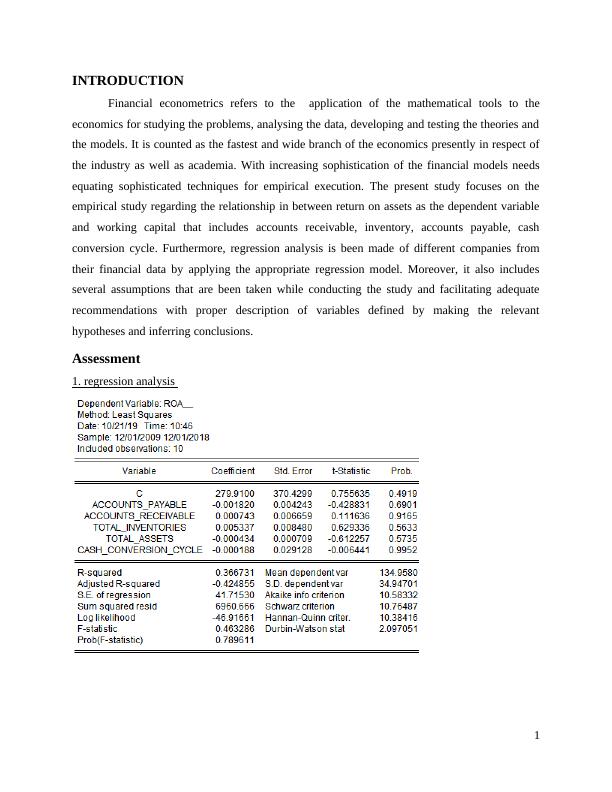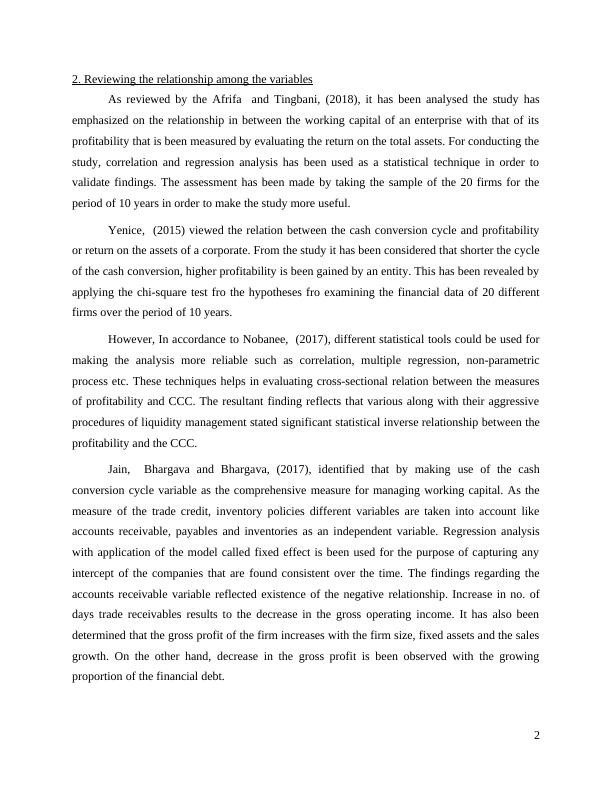(Solution) Regression Analysis : PDF
Added on 2021-02-20
20 Pages5138 Words30 Views
Financial Reporting

TABLE OF CONTENTS
INTRODUCTION...........................................................................................................................1
Assessment.......................................................................................................................................1
1. regression analysis .................................................................................................................1
2. Reviewing the relationship among the variables....................................................................2
(3) Specification of model and hypothesis..................................................................................6
(4) Data, variables and sources...................................................................................................7
(5) Documenting in standard format...........................................................................................8
(6) Analysis of results.................................................................................................................9
Conclusion and recommendation .............................................................................................11
CONCLUSION .............................................................................................................................12
REFERENCES .............................................................................................................................13
APPENDIX....................................................................................................................................14
INTRODUCTION...........................................................................................................................1
Assessment.......................................................................................................................................1
1. regression analysis .................................................................................................................1
2. Reviewing the relationship among the variables....................................................................2
(3) Specification of model and hypothesis..................................................................................6
(4) Data, variables and sources...................................................................................................7
(5) Documenting in standard format...........................................................................................8
(6) Analysis of results.................................................................................................................9
Conclusion and recommendation .............................................................................................11
CONCLUSION .............................................................................................................................12
REFERENCES .............................................................................................................................13
APPENDIX....................................................................................................................................14

INTRODUCTION
Financial econometrics refers to the application of the mathematical tools to the
economics for studying the problems, analysing the data, developing and testing the theories and
the models. It is counted as the fastest and wide branch of the economics presently in respect of
the industry as well as academia. With increasing sophistication of the financial models needs
equating sophisticated techniques for empirical execution. The present study focuses on the
empirical study regarding the relationship in between return on assets as the dependent variable
and working capital that includes accounts receivable, inventory, accounts payable, cash
conversion cycle. Furthermore, regression analysis is been made of different companies from
their financial data by applying the appropriate regression model. Moreover, it also includes
several assumptions that are been taken while conducting the study and facilitating adequate
recommendations with proper description of variables defined by making the relevant
hypotheses and inferring conclusions.
Assessment
1. regression analysis
1
Financial econometrics refers to the application of the mathematical tools to the
economics for studying the problems, analysing the data, developing and testing the theories and
the models. It is counted as the fastest and wide branch of the economics presently in respect of
the industry as well as academia. With increasing sophistication of the financial models needs
equating sophisticated techniques for empirical execution. The present study focuses on the
empirical study regarding the relationship in between return on assets as the dependent variable
and working capital that includes accounts receivable, inventory, accounts payable, cash
conversion cycle. Furthermore, regression analysis is been made of different companies from
their financial data by applying the appropriate regression model. Moreover, it also includes
several assumptions that are been taken while conducting the study and facilitating adequate
recommendations with proper description of variables defined by making the relevant
hypotheses and inferring conclusions.
Assessment
1. regression analysis
1

2. Reviewing the relationship among the variables
As reviewed by the Afrifa and Tingbani, (2018), it has been analysed the study has
emphasized on the relationship in between the working capital of an enterprise with that of its
profitability that is been measured by evaluating the return on the total assets. For conducting the
study, correlation and regression analysis has been used as a statistical technique in order to
validate findings. The assessment has been made by taking the sample of the 20 firms for the
period of 10 years in order to make the study more useful.
Yenice, (2015) viewed the relation between the cash conversion cycle and profitability
or return on the assets of a corporate. From the study it has been considered that shorter the cycle
of the cash conversion, higher profitability is been gained by an entity. This has been revealed by
applying the chi-square test fro the hypotheses fro examining the financial data of 20 different
firms over the period of 10 years.
However, In accordance to Nobanee, (2017), different statistical tools could be used for
making the analysis more reliable such as correlation, multiple regression, non-parametric
process etc. These techniques helps in evaluating cross-sectional relation between the measures
of profitability and CCC. The resultant finding reflects that various along with their aggressive
procedures of liquidity management stated significant statistical inverse relationship between the
profitability and the CCC.
Jain, Bhargava and Bhargava, (2017), identified that by making use of the cash
conversion cycle variable as the comprehensive measure for managing working capital. As the
measure of the trade credit, inventory policies different variables are taken into account like
accounts receivable, payables and inventories as an independent variable. Regression analysis
with application of the model called fixed effect is been used for the purpose of capturing any
intercept of the companies that are found consistent over the time. The findings regarding the
accounts receivable variable reflected existence of the negative relationship. Increase in no. of
days trade receivables results to the decrease in the gross operating income. It has also been
determined that the gross profit of the firm increases with the firm size, fixed assets and the sales
growth. On the other hand, decrease in the gross profit is been observed with the growing
proportion of the financial debt.
2
As reviewed by the Afrifa and Tingbani, (2018), it has been analysed the study has
emphasized on the relationship in between the working capital of an enterprise with that of its
profitability that is been measured by evaluating the return on the total assets. For conducting the
study, correlation and regression analysis has been used as a statistical technique in order to
validate findings. The assessment has been made by taking the sample of the 20 firms for the
period of 10 years in order to make the study more useful.
Yenice, (2015) viewed the relation between the cash conversion cycle and profitability
or return on the assets of a corporate. From the study it has been considered that shorter the cycle
of the cash conversion, higher profitability is been gained by an entity. This has been revealed by
applying the chi-square test fro the hypotheses fro examining the financial data of 20 different
firms over the period of 10 years.
However, In accordance to Nobanee, (2017), different statistical tools could be used for
making the analysis more reliable such as correlation, multiple regression, non-parametric
process etc. These techniques helps in evaluating cross-sectional relation between the measures
of profitability and CCC. The resultant finding reflects that various along with their aggressive
procedures of liquidity management stated significant statistical inverse relationship between the
profitability and the CCC.
Jain, Bhargava and Bhargava, (2017), identified that by making use of the cash
conversion cycle variable as the comprehensive measure for managing working capital. As the
measure of the trade credit, inventory policies different variables are taken into account like
accounts receivable, payables and inventories as an independent variable. Regression analysis
with application of the model called fixed effect is been used for the purpose of capturing any
intercept of the companies that are found consistent over the time. The findings regarding the
accounts receivable variable reflected existence of the negative relationship. Increase in no. of
days trade receivables results to the decrease in the gross operating income. It has also been
determined that the gross profit of the firm increases with the firm size, fixed assets and the sales
growth. On the other hand, decrease in the gross profit is been observed with the growing
proportion of the financial debt.
2

End of preview
Want to access all the pages? Upload your documents or become a member.
Related Documents
Impact of Working Capital Management and Corporate Governance on Firm Performancelg...
|24
|6813
|72
Working Capital Management and its Impact on Profitability: Evidence from ASX listed Construction Firmslg...
|18
|4777
|378
Cash Conversion Cycle Case Study 2022lg...
|7
|1230
|25
Impact of Working Capital Management of Meghna Cement Millslg...
|15
|1557
|17
Financial Econometrics Concept PDFlg...
|18
|5600
|218
Financial Ratio Evaluation Reportlg...
|20
|3480
|1